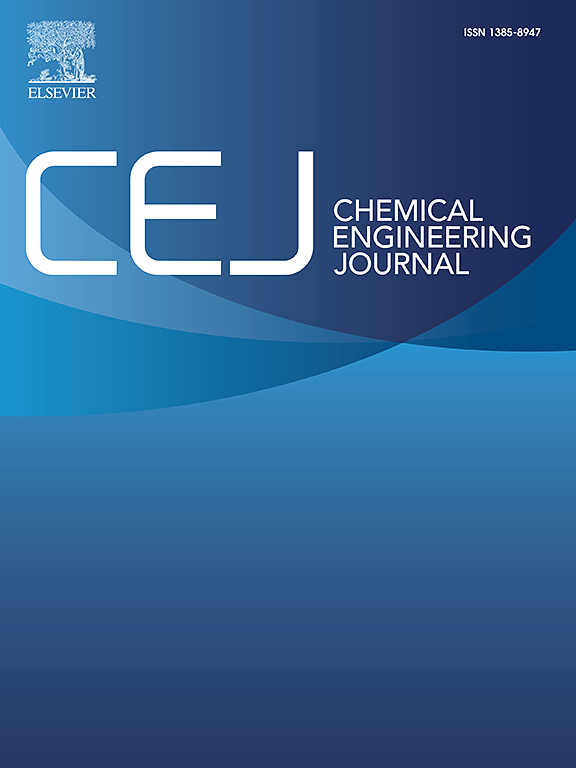Carrier-free multifunctional nanomedicine for enhanced hyperthermic intraperitoneal chemotherapy against abdominal pelvic tumors
IF 13.3
1区 工程技术
Q1 ENGINEERING, CHEMICAL
引用次数: 0
Abstract
Hyperthermic intraperitoneal chemotherapy (HIPEC) as an innovative approach in cancer therapy can deliver heated drugs directly into the abdominal cavity. Nevertheless, HIPEC also promotes upregulation of heat shock proteins, potentially leading to resistance against hyperthermia. Herein, novel nanoparticles self-assembled from gambogic acid (GA) and metformin (Met) are prepared through multiple interactions, enabling HIPEC for the treatment of orthotopic colorectal and ovarian cancers. Briefly, mild heat (abbreviated as MH) triggers immunogenic cell death (ICD) of cancer cells, leading to the release of damage-associated molecular patterns (DMAPs) that boost the immunogenicity of tumor microenvironment. GA, a potent inhibitor of heat shock protein (HSP-90), increases the sensitivity of cancer cells to hyperthermia-induced cell death. Moreover, GA acts as a chemotherapeutic agent itself, effectively inducing apoptosis of cancer cells and amplifying the ICD induced by MH. Met, can efficiently clear the tumor extracellular matrixes to facilitate the deeper penetration of nanoparticles into tumor tissues and promotes the infiltration of cytotoxic T lymphocytes. More importantly, the synergistic combination of GA and Met during HIPEC triggers a robust anti-tumor immune response in vivo. This integrated strategy offers a promising therapeutic avenue for the management of advanced abdominal pelvic tumor, possessing the potential for broad clinical applications.用于腹腔盆腔肿瘤热疗腹腔内化疗的无载体多功能纳米药物
腹腔内热化疗(HIPEC)作为癌症治疗的一种创新方法,可将加热药物直接送入腹腔。然而,HIPEC 也会促进热休克蛋白的上调,从而可能导致对热疗的抵抗。在本文中,甘草酸(GA)和二甲双胍(Met)通过多重相互作用制备了新型纳米颗粒,使HIPEC成为治疗正位结直肠癌和卵巢癌的方法。简而言之,微热(缩写为 MH)会引发癌细胞的免疫原性细胞死亡(ICD),导致损伤相关分子模式(DMAPs)的释放,从而增强肿瘤微环境的免疫原性。GA是一种强效的热休克蛋白(HSP-90)抑制剂,能提高癌细胞对热疗诱导的细胞死亡的敏感性。此外,GA本身也是一种化疗药物,能有效诱导癌细胞凋亡,并放大MH诱导的ICD。Met能有效清除肿瘤细胞外基质,促进纳米粒子更深入地渗透肿瘤组织,并促进细胞毒性T淋巴细胞的浸润。更重要的是,在 HIPEC 期间,GA 和 Met 的协同作用可在体内引发强大的抗肿瘤免疫反应。这种综合策略为晚期腹腔盆腔肿瘤的治疗提供了一条前景广阔的治疗途径,具有广泛的临床应用潜力。
本文章由计算机程序翻译,如有差异,请以英文原文为准。
求助全文
约1分钟内获得全文
求助全文
来源期刊

Chemical Engineering Journal
工程技术-工程:化工
CiteScore
21.70
自引率
9.30%
发文量
6781
审稿时长
2.4 months
期刊介绍:
The Chemical Engineering Journal is an international research journal that invites contributions of original and novel fundamental research. It aims to provide an international platform for presenting original fundamental research, interpretative reviews, and discussions on new developments in chemical engineering. The journal welcomes papers that describe novel theory and its practical application, as well as those that demonstrate the transfer of techniques from other disciplines. It also welcomes reports on carefully conducted experimental work that is soundly interpreted. The main focus of the journal is on original and rigorous research results that have broad significance. The Catalysis section within the Chemical Engineering Journal focuses specifically on Experimental and Theoretical studies in the fields of heterogeneous catalysis, molecular catalysis, and biocatalysis. These studies have industrial impact on various sectors such as chemicals, energy, materials, foods, healthcare, and environmental protection.
 求助内容:
求助内容: 应助结果提醒方式:
应助结果提醒方式:


